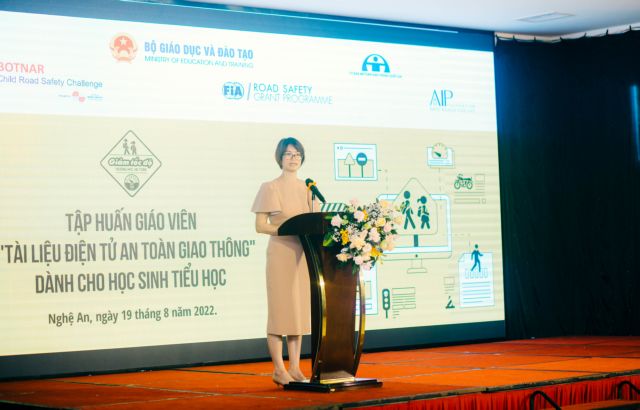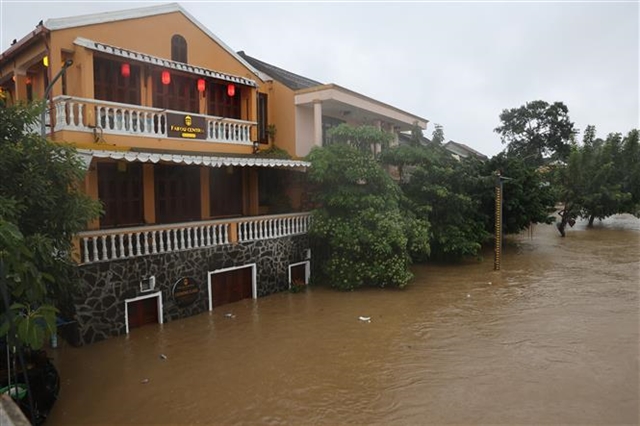 Society
Society

 |
| Phạm Hùng Anh, Director of the Department of Student Affairs, from the Ministry of Education and Training, addressed the workshop. — Photo courtesy of AIP Foundation |
NGHỆ AN — The Ministry of Education and Training (MOET) and the National Traffic Safety Committee (NTSC) in collaboration with AIP Foundation, is hosting from August 19 a regional training workshop to train teachers on a new traffic safety e-curriculum to help safeguard vulnerable school children across the country.
Safe mobility and easy commuting to school are at the heart of everyone’s access to education. Around the world, many children are safe on their way to school by taking public transportation, by riding or by walking on safe roads. However, not every student in Việt Nam enjoys equal safety on their way to and from school.
Thanks to the Slow Zones, Safe Zones programme, the hybrid training will welcome over 6,000 teachers from 63 provinces in Việt Nam who will learn the basics of the new traffic safety e-curriculum as 'master trainers'. They will also learn how it can best be used to engage students in learning lifelong road safety skills in a creative and interactive manner.
The master trainers will gain in-depth insight, which they can impart, to teachers who will spread their new knowledge to their students, which can contribute to long-term sustainability for safe mobility in Việt Nam.
In April 2022, the traffic safety e-curriculum – as part of the Slow Zones, Safe Zones programme – was approved to be implemented nationwide. Bringing mobility equity to primary school students in Việt Nam, the Ministry of Education and Training signed the Official Legal Decision No.946 /QĐ-‐BGDĐT to approve its use as an official school material for integrated teaching and activities on traffic safety education. The e-curriculum provides an effective and creative student-centred educational tool for primary students to learn essential traffic safety skills from a young age. From now, whichever mode of transport the students choose, they will be safer. This is the first nationwide-applied traffic safety e-curriculum for primary students in Việt Nam.
Phạm Hùng Anh, Director of the Department of Student Affairs, from the Ministry of Education and Training shared, “We are so proud to be hosting the first training session on the traffic safety e-curriculum and truly celebrate that it has been adopted for nationwide implementation. It will now be used as a tool to safeguard every child in Việt Nam on their way to and from school. This milestone today marks the beginning of a new era of safe mobility across our country.”
The e-curriculum takes into account the variety of commuting in Việt Nam with seven main transportation modes included, from cycling to boat travel, as well as knowledge and skills including safe journeys to school, road traffic signs, road crash consequences, and avoiding road crashes. Provided through an online platform, it can be taught in class by teachers – as part of the fundamental knowledge provided by the school – but also accessed by every child from home to learn independently how to behave safely on the road. The course features interactive videos, games, and activities designed to teach students life-saving skills related to safer road behaviours.
The successful pilot of the traffic safety e-curriculum and approval from the MOET has provided a solid foundation to scale up the curriculum nationwide. Trainings of trainers will ensure that the curriculum content and purpose is adequately and effectively transferred to students. The trainings are conducted with a community-led approach in mind, first at the national level, organized by the MOET for core teachers representing 63 provinces in Việt Nam, and then at the provincial level, organized by DOETs for core teachers to pass down their knowledge and skills to colleagues from local schools in their respective communities.
By creating networks of trainers at the local and national level through training activities, key stakeholders are empowered to serve as project ambassadors and educators within their own respective spheres of influence. Extending beyond the target provinces under Slow Zones, Safe Zones, capacity building for teachers will ensure that students from across the country will have access to these materials, and in turn contribute to building a young generation of smart road users, creating a chain of long-term positive impact and sustainability for safe mobility.
 |
| Hoàng Thị Na Hương, Deputy Chief Executive Officer at AIP Foundation, spoke at the workshop held in Nghệ An Province. — Photo courtesy of AIP Foundation |
Hoàng Thị Na Hương, Deputy Chief Executive Officer at AIP Foundation shared, “Children and young adults are at the heart of this program and our work because they are the generation of tomorrow. It is their roads, their school and their lives that will be safeguarded by the traffic safety e-curriculum.”
The overall purpose of the Slow Zones, Safe Zones programme is to reduce road crash injuries and fatalities in school zones.
This programme, which aims to improve the safety of students’ journeys to and from schools, is supported by Fondation Botnar, the Global Road Safety Partnership, the Fédération Internationale de l’Automobile, and the International Road Assessment Programme, and aligns with the Global Plan of the Decade of Action for Road Safety 2021-30. Similarly, Việt Nam’ current National Road Safety Strategy supports meeting the goals of the 2030 UN Agenda for Sustainable Development, ensuring maximum traffic safety for school zones around the country. — VNS




